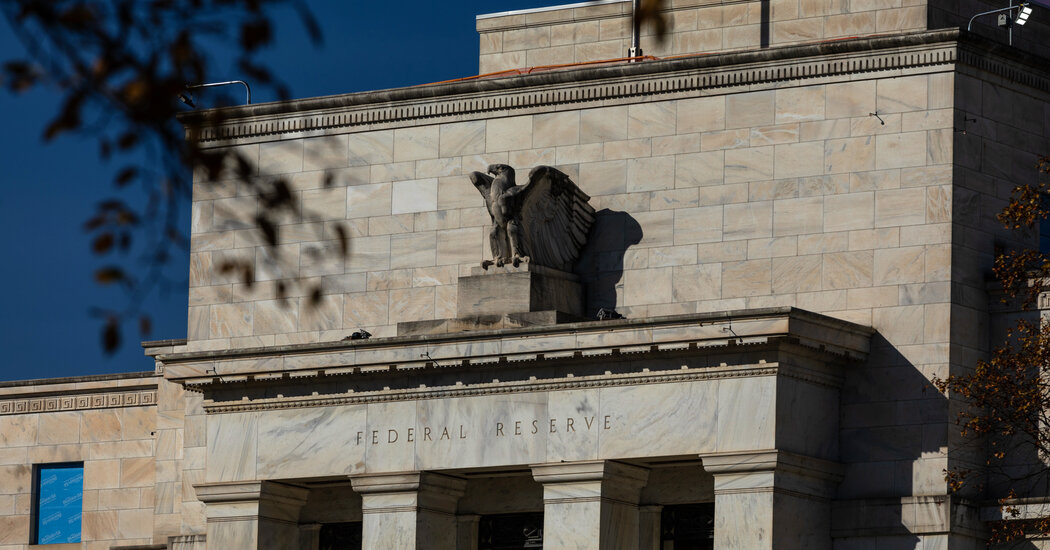The country’s biggest banks have long complained that the Federal Reserve’s stress tests are overly onerous and opaque. On Friday, the members of the central bank’s Board of Governors prepared to give banks many of the changes they had long sought.
Introduced in the aftermath of the 2008 financial crisis, the annual exams test how banks would withstand various disaster scenarios. Regulators then impose capital buffer requirements on each bank, forcing them to hold assets as a cushion against future losses. Banks prefer to keep those buffers as small as possible, which gives them more leeway to lend and invest.
The changes would eliminate much of the secrecy around the exams by requiring the Fed to publish in advance the models it will use for the exams and the specific economic scenarios it will test each year.
The board planned to vote Friday afternoon on its proposed overhaul. In statements ahead of the vote, a majority of the seven governors indicated support of the proposed changes. Only one governor, Michael Barr, expressed opposition.
The proposed exam changes are not expected to meaningfully alter the capital requirements for the companies subject to the tests, the board said. The proposal will be open until late January for public comment before it is enacted.
The proposed change came after a coalition of trade groups sued the Federal Reserve in late 2024 over what they called “vacillating and unexplained requirements” in the exam process. The banks sought clearer guidance on the standards applied during the tests and on the scenarios that would be tested.
Because the Fed indicated a willingness to alter its testing process, the litigation was paused this year to give the trade groups and the Fed time to try to resolve their dispute through the federal government’s rule-making process. Jerome H. Powell, the Fed’s chair, said the proposed changes were a “step” toward “improving the transparency of the stress tests and reducing the volatility of resulting capital buffer requirements.”
Michelle Bowman, who spearheaded these changes in her role as vice chair for supervision, said in a statement that the proposal was a “necessary improvement to promote due process and transparency.”
The Fed’s recent exam scenarios included hypotheticals like a spike in unemployment, a 50 percent plunge in the stock market and sharp decreases in commercial real estate and home prices.
The new proposal includes both publishing the scenarios in advance and opening them up for public comment before they are adopted.
The board released a 42-page draft on Friday of its planned 2026 scenarios, which include “a hypothetical severe global recession” prompted by a steep drop in the prices of some risky assets. That doomsday case envisions an unemployment rate that surpasses 10 percent and a real-estate market collapse that slashes home prices by nearly 30 percent.
Bank executives say that knowing in advance the situations the Fed plans to test and the models it intends to use would help them prepare for exams that carry significant consequences. Fluctuating capital requirements — adjusted annually by the Fed in response to the exam results — create “significant and unpredictable volatility” for banks, the trade groups said in their lawsuit.
But some legal experts warn that those disclosures would enable banks to game the results in order to lower their capital requirements.
Mr. Barr, who was replaced as vice chair for supervision by Ms. Bowman this year but remains a governor, said in a statement opposing the changes that disclosing the models and scenarios would make the stress tests “weaker and less credible.”
The Fed’s proposed changes “risk turning the stress test into an ossified exercise that will provide illusory comfort in the resilience of the system,” he added. “Altogether, these changes will leave banks in a worse position to weather stress.”
But Mr. Barr appeared to be alone in his opposition to the proposed changes. Christopher Waller, another governor, said the adjustments would “improve accountability” and also “build confidence in the fairness of the process.”
Stephen Miran, the newest member of the Fed’s Board of Governors, said the changes would “increase confidence in his results,” even as he criticized the scenarios the central bank designed for the banks.
“Using conceptually sound scenarios for assessing tail risks may be more valuable than relying on inherently inconsistent assumptions to achieve a desired level of stress,” he said in a statement.
The decision on stress tests comes on the heels of other changes to the rules and regulations that govern Wall Street. This year, the Fed reduced a capital buffer for the eight biggest banks, which are considered the most systemically important given their size and ties to the overall financial system.
Last month, the Fed also agreed to reduce the capital buffer specifically for Morgan Stanley, cutting it to 4.3 percent from 5.1 percent in response to an appeal the bank filed after this year’s exam results were released. The Fed said that upon further review, it decided to adjust its loss estimates in ways that favored the bank.
Stacy Cowley is a Times business reporter who writes about a broad array of topics related to consumer finance, including student debt, the banking industry and small business.
Colby Smith covers the Federal Reserve and the U.S. economy for The Times.
The post Fed Prepares Bank-Friendly Changes to Annual Stress Tests appeared first on New York Times.




